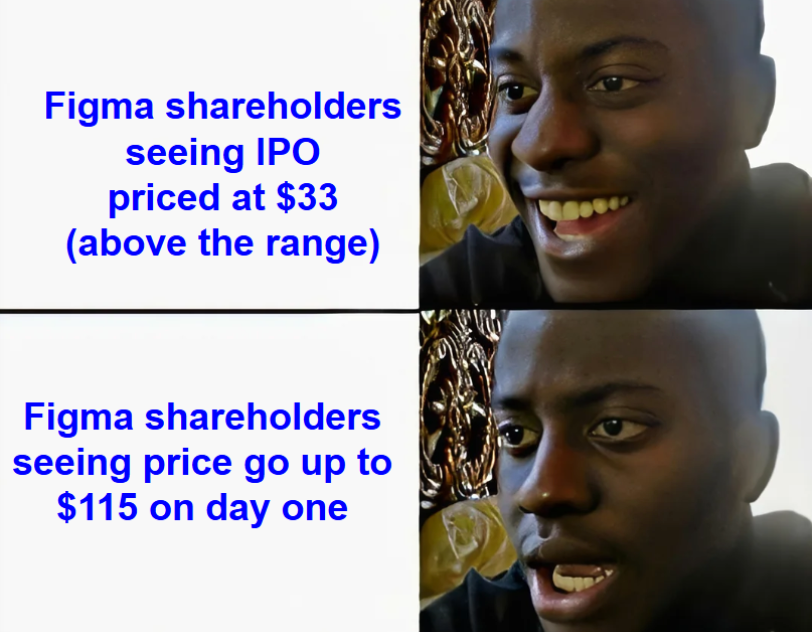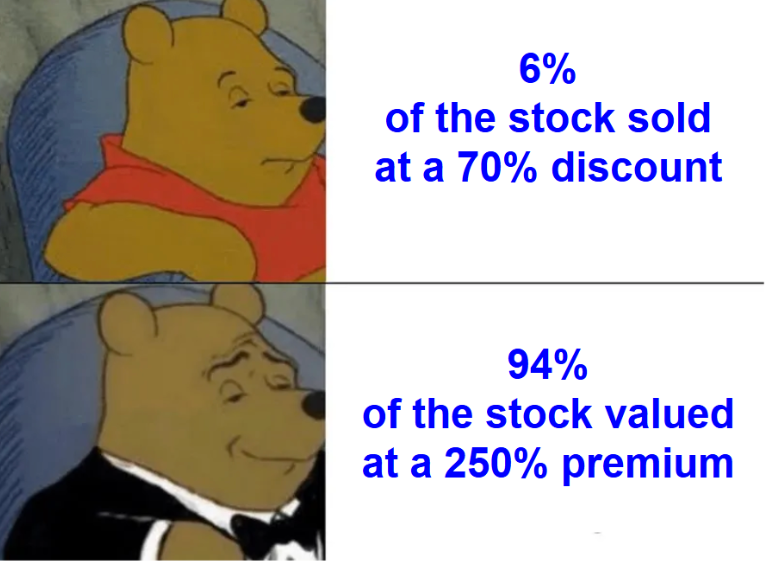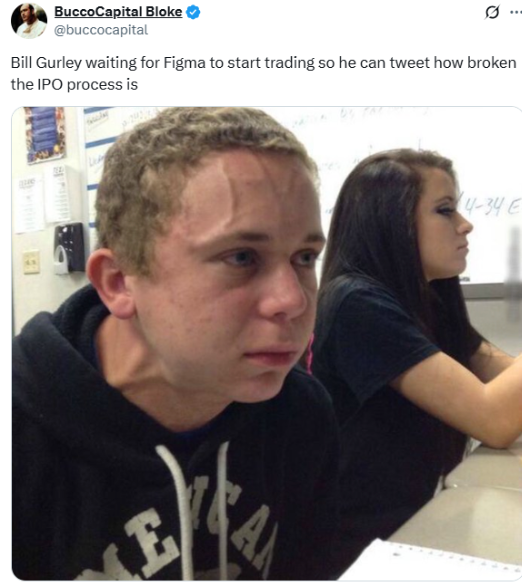🧐 Was Figma's IPO pricing dumb or genius?
Hey there,
It’s Jaime again, writing to you from Colorado this week, after spending the weekend celebrating my son’s 4th birthday. In between sugar crashes, I found myself pondering about Figma’s IPO…
When I first drafted this, Figma had just closed its IPO day at $115.50 — a 250% pop. But now, as I hit send, the stock is trading closer to $80. Which begs the question: who really benefited? Because what looked like a $3B “gain” is now… not.
A few weeks ago, I wrote about how the IPO window was reopening, and how banks were intentionally undercutting pricing to manufacture strong debuts. Figma just gave us the most extreme version of that. A 250% pop, and subsequent ~50% drop. Kind of Wall Street’s version of a sugar high.
Let’s unpack it.
🎊 Figma’s 250% IPO pop: Brilliant strategy or $3B mistake?
Figma’s blockbuster IPO shocked the market. Priced at $33 per share, it opened at $85 and closed day one at $115.50, a staggering 250% pop. The move reignited a long-standing debate in tech and finance circles: was this a mispriced IPO that left billions on the table? Or a genius play that used a small float and big demand to reprice the rest of the company higher?
Let’s unpack how IPO pricing actually works, and whether Figma’s leadership pulled off something smart or got played by Wall Street.

💲 How IPO pricing works, and why demand quality matters
In a traditional IPO, banks run a “book-building” process to gauge demand from investors. But not all demand is equal. Long-term mutual funds are considered “strong hands,” while hedge funds and short-term traders are more likely to flip shares right away.
That’s why I believe allocation matters. A book full of fast-money players can lead to volatility. A book anchored by long-only funds tends to trade more steadily.
You’ll often hear: “It was 10x subscribed!”.... Yiehhh. But in hot deals, investors inflate orders to get a slice, sometimes many times what they actually want. So 30x oversubscribed doesn’t mean quality demand. In fact, I feel 5x with the right investors can be better than 30x with “easy flippers”.
🌪️ Figma’s IPO: scarcity meets frenzy
Figma floated just 36.9 million shares, or about 6% of the company. The rest stayed locked up with employees, founders, and VCs. The deal was reportedly over 30x subscribed.
With so little supply and huge demand, the stock exploded. Classic IPO pop: investors piled in, FOMO took over, price went vertical.
But here is the thing… According to Figma’s official filing, only a tiny slice was sold at $33 (or a $18B company valuation). The remaining 94% of the company was suddenly worth over $60B.
Was that intentional?

🍿 A strategic pop?
Based on the Company’s filing, Figma’s IPO raised about $1.2B. Only ~$412M of that went to the company; the rest went to selling shareholders. But the pop boosted the value of all remaining equity. For early investors and insiders, that meant billions in new paper gains.
This strategy of small float, low price, big pop might be more calculated than it looks. If Figma had priced shares at $60 or $70, maybe it could have raised more. But the stock wouldn’t have soared, and the broader “marketing effect” might have been lost.
Instead, Figma got a viral moment: “The IPO is back!” headlines, social media buzz, and strong institutional support. In a tight IPO market, that kind of momentum may be worth the trade-off.
🙊 Or was it a massive mistake?
Critics say Figma left billions on the table. Prominent VC Bill Gurley slammed the deal, arguing the IPO was “expected and intentional”, a transfer of wealth from the company to Wall Street clients. He estimated that $2.6B was “left behind,” with over $1.7B in value missed by selling shareholders alone (Source: Bill Gurley (@bgurley on X), July 31, 2025).

One particularly striking data point: a charitable foundation that Figma’s co-founder had gifted shares to sold hundreds of millions worth at the IPO price. At $115, those shares would’ve been worth nearly three times as much (Source: Business Insider as of July 31, 2025).
This is the core of Gurley’s argument: the traditional IPO model rewards the buyers of IPO shares, not the company or the people who built it. Investment banks underprice IPOs to keep their institutional clients happy. These clients get shares at a discount, flip them on day one, and collect risk-free gains. It’s a broken system is what Gurley advocates (Source: Bill Gurley (@bgurley on X), July 31, 2025).
So why not go the direct listing route?
🛣️ Direct Listing: A different route
In a direct listing, there’s no IPO price, no banker allocations, just the market setting the price. Spotify, Slack, and Coinbase did it.
Figma could’ve gone that route. It didn’t need the cash. But direct listings come with trade-offs: no guaranteed raise, more price volatility.
Instead, Figma may have chosen the traditional IPO because it wanted some proceeds, some control, and some market support. But in my view, the cost was high: Wall Street clients made a fortune; Figma walked away with a relatively modest raise and a now sky-high valuation to live up to.
👀 The employee view
From an employee perspective, the massive pop is bittersweet. On one hand, it suggests that the company is valued highly, great news for morale and future liquidity. But employees couldn’t sell on day one. If the stock comes down before the lock-up ends, that $115 peak may be an illusion.
This has happened before. Snowflake popped on IPO day and closed at $254. Four years later, it still trades below that level, despite strong growth. For insiders who couldn’t sell right away, the market’s first-day price was just a headline.
Figma’s leadership now has to manage expectations. The bar has been set high. To justify a $60B+ valuation, the company will need to deliver fast.
🧠 So…was it dumb or genius?
If you're a hedge fund that got IPO shares: genius. You just made a 250% return in a day.
If you're a long-term investor who believes in Figma: still great. You got in early, even if you didn’t get IPO allocations.
If you're a Figma employee: mixed. You’re holding gold if the valuation holds. But your ability to capture value depends on future performance, not the day-one frenzy.
If you're Figma’s leadership: you likely got exactly what you wanted. A strong market debut, minimal dilution, and a re-rating of your entire company. That said, critics will keep pointing at the billions left behind.
🥡 Final takeaways
- IPO pricing is a delicate dance. It’s not just about demand quantity. It’s about demand quality. Who gets the stock matters.
- Figma’s strategy of limited float + strong demand = massive pop. Whether this was smart or reckless depends on your goals.
- Employees and founders need to understand the IPO game. You don’t get to sell on day one. Valuation is a moving target. Lock-up expiries, market conditions, and company performance all matter more than the first-day price.
- The debate isn’t going away. Bill Gurley and others will keep calling out the system. But for now, this is the market playbook: engineer the pop, build the buzz, and figure the rest out later.
Things we’re digging:
- 🤖 ChatGPT is now in the hands of the U.S. government for the low price of $1.
- 🪨 Utility workers in Peru unearthed a pre-Incan tomb with 1,000-year-old remains. Not your average day on the job.
- 🌭 A hot dog spill shut down a highway in Pennsylvania...truly a commuter’s wurst nightmare.